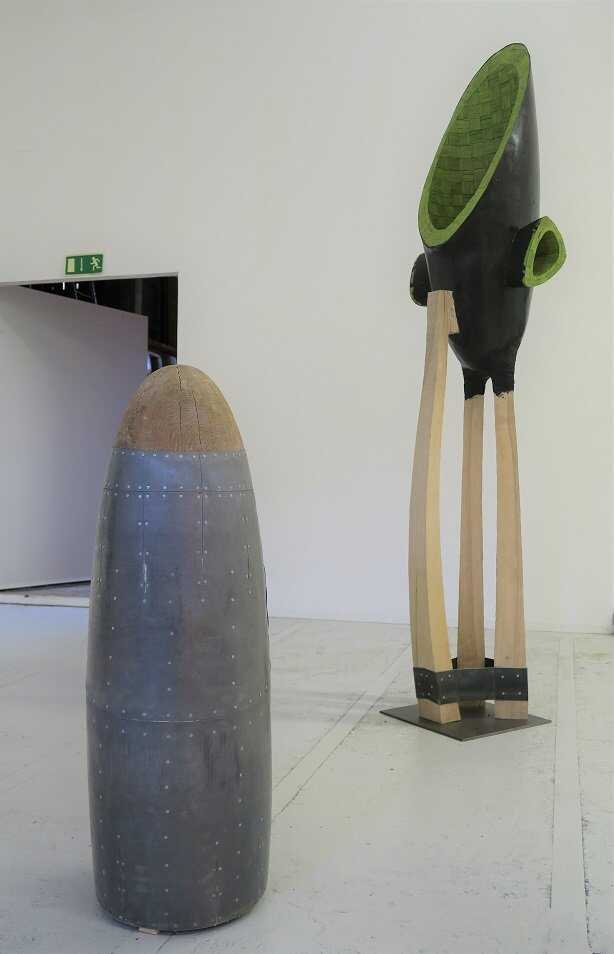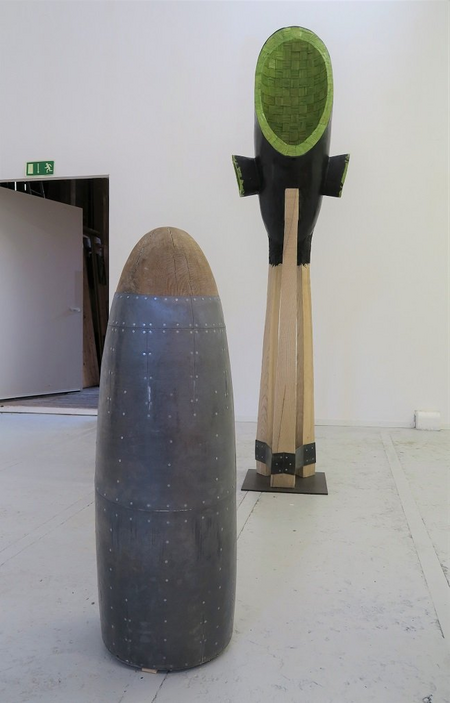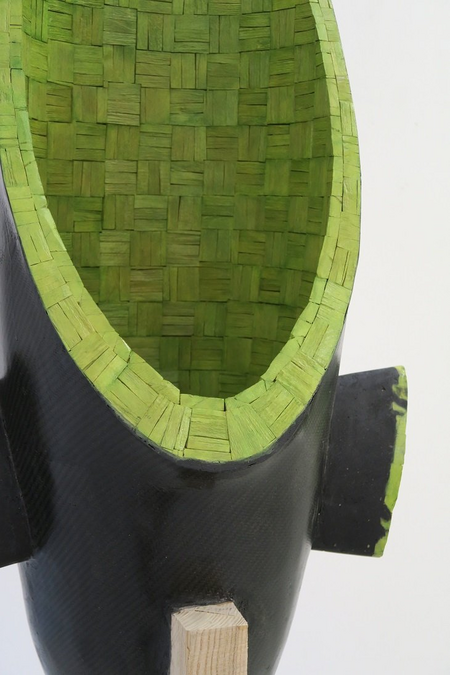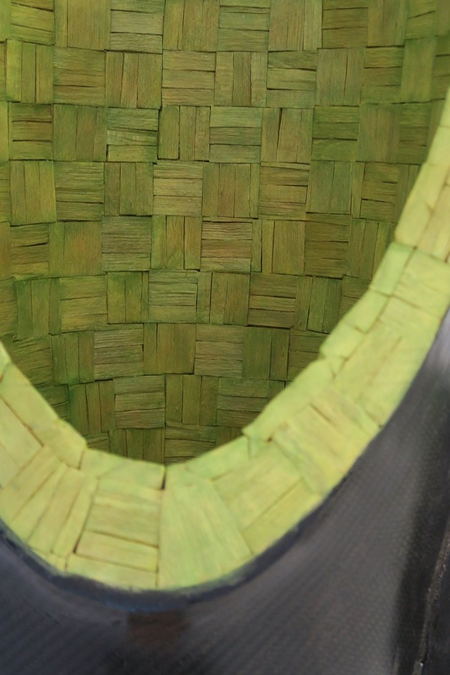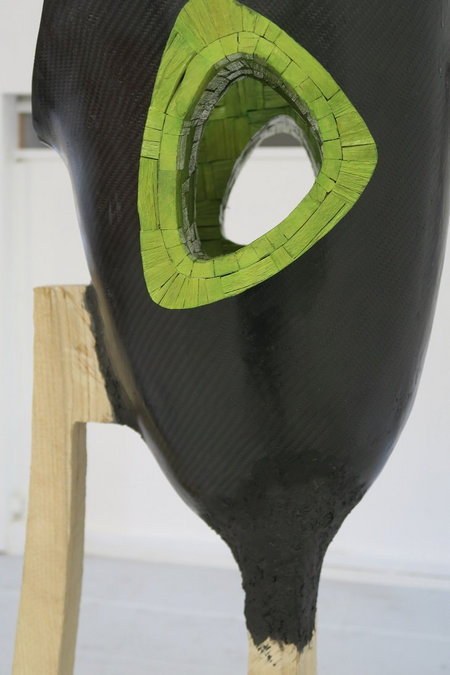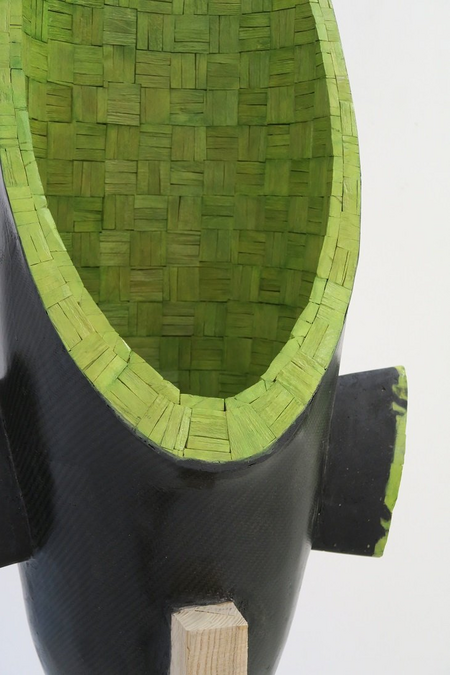Cleopatra / Caesar – does the winner take it all?
Two unequal parts face each other, both standing; a large flower pot shaped form, open towards the top, balancing on three thin stilts (Cleopatra), and a squat oak wood cone, covered in lead except for its very top (Caesar). The heavy, earthbound cone is not a bomb, not a ballistic projectile; it is the analogous counterpart that was needed to construct the flower pot cavity from hundreds of small bits of wood. Thus originally the parts belong together - now they are separate. A reference to two ancient personages or even cultural groups? Perhaps, insofar as the names of the protagonists stand for fundamentally different perspectives of the world as a whole; Cleopatra as a pharaoh of the late phase of ancient Egypt with its mythology of transcendency and the animistic Horus cult, Caesar as the first dictator of the Roman Empire with a materialistic pantheism, personalized belief in gods and territorial wars of conquest. Which ideology will gain the upper hand? The question is obsolete as soon as we realize that the optimal stand is in between - with antenna in the spiritual transcendency and roots in the tangible substantiality.
beechwood (bit-technique), coloured translucent varnish; epoxy resin; carbon fibre laminate; steel (Cleopatra);oak wood covered with plates of lead (Caesar)
Zwei ungleiche Teile stehen einander gegenüber, beide aufgerichtet; eine grosse, gegen oben geöffnete Blütenbecherform, auf drei dünnen Stelzen thronend (Kleopatra) und ein gedrungener Eichenholz-Konus, bis auf die Spitze mit Blei überzogen (Caesar). Der schwere, erdgebundene Konus ist keine Bombe, kein ballistisches Geschoss, es ist die passgenaue Gegenform, die zum Aufbau des Blütenbecher-Hohlraums aus hunderten kleiner Holzstücke benötigt wurde. Ursprünglich gehören sie zusammen – nun sind sie getrennt. Eine Referenz an zwei antike Persönlichkeiten oder gar Kulturkreise? Mag sein, insofern sie für zwei unterschiedliche Blickwinkel auf das Ganze stehen; Kleopatra als Pharaonin der Spätphase des alten Ägyptens mit einer dem Transzendenten zugewandten Mythologie und dem animistischen Horus-Kult, Caesar als erster Diktator des römischen Reichs mit einem materialistischen Pantheismus, vermenschlichten Götterglauben und territorialen Eroberungskriegen. Welche Weltanschauung gewinnt die Oberhand? Die Frage ist obsolet, wenn uns bewusst wird, dass wir dazwischenstehen können – mit Fühlern ins Spirituell-Transzendente und Wurzeln im Irdisch-Stofflichen.
Buche - Holzaufbau und Carbonlaminat / olivgrüne Lasur / Eschenholz-Stelzen (Kleopatra); Eichenholz mit Bleiplatten überzogen (Caesar)
Kleopatra / Caesar - alles für den Gewinner?
Datenblatt
- Abmessungen
- 300cm, 265cm, 100cm (Höhe, Breite, Tiefe)
- Gewicht
- 140kg
- Jahr
- 2022
- Material
- Kunstharz, Metall, Mixed Media, Holz
